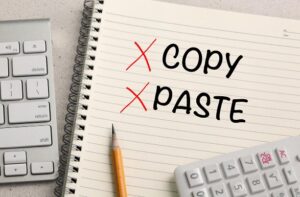

Students use copy-paste more often than other Internet users when writing scientific papers. There are no restrictions for them, because filling them with copied information does not bring profit. But the same cannot be said about large company websites. In this case, copy-paste (from the English “copy”, “paste”) threatens with serious consequences.
It is quite easy to become familiar with the principles and detect the appearance of unwanted inserts. Use accessible explanations about what copy-paste means to avoid sanctions from the copyright holder and search engines. Quality control of publications takes time, but the results are worth it.

Plagiarism in any form has always been condemned by society, so it is not surprising that the term began to be used back in the 17th century. Back then, copying other people’s works was called “working with scissors and a pot of glue.” The literary critic in this way hinted at those authors who inserted excerpts from the texts of other writers.
Now copy-pasting means appropriating the merits of others, and it is now much easier to detect this. In order to determine copying, various anti-plagiarisms are used – resources that point to parts from other texts, sites and sources in general.
A novice copywriter, faced with a new topic, also resorts to plagiarism. Lack of knowledge leads to the fact that some information is copied from the text of a journalist or author. However, there is a line between completely rewriting sentences and paraphrasing expressions.
The last thing is rewriting. A direction in copywriting that involves writing material based on an example. The author keeps the idea, but explains it in his own way, without breaking the rules. Thanks to this processing, services will not be able to distinguish rewritten text, and the uniqueness indicator will confirm this.
Since copy-paste is an undesirable phenomenon, it is worth explaining the consequences. A business that uses copied materials on a website is liable in the form of:
To avoid this situation, companies check one text on several services and then evaluate the results.
And now the anti-plagiarism service comes to the rescue. Checking any text does not cause problems: just copy the selected material (or part of it) and give a command to the algorithm. The result is presented in the form of links to similar articles and a uniqueness indicator as a percentage.
Copy-paste checking is possible thanks to special algorithms. Considering that the number of verification services reaches more than 30 options, uniqueness may vary significantly. In view of this, you need to pay attention to the indicators in cases where large passages are highlighted on the page with the results. In addition, uniqueness of 80% or more is considered acceptable.
The same anti-plagiarism will help you detect that your texts are posted on third-party sites. You know what copy-paste means in Internet slang and that the article was written by you, so checking will allow you to find plagiarists who decided not to waste time creating their own materials. What to do if the results show “borrowing” of the original text? There are several options:
Consider using another company’s mistake to benefit your own, and add to the list of requirements an offer to include information about the original source. What the algorithms decide about such a compromise in the event of a violation is not your concern, because the decisions will in no way affect you.
Despite the fact that copy-pasting text is a little nice, it is worth minimizing the possibilities of copy-pasting and protecting the original publications. The best control methods depend on the type of material published. So, to protect copyright, use the one that meets the requirements:
Of course, it is impossible to completely exclude the borrowing of copyright ideas. But it’s worth trying. When there is a feeling of imminent punishment, no one will think what it means to copy-paste. Instead, it’s better to spend your time creating your own (less) perfect content.